and historical purposes, all rights reserved.
This page is copyright© by
This page may not be sold or distributed without
the expressed permission of the producer.
I have no connection with any camera company.
On-line camera manual library
Back to main on-line manual page
If you find this manual useful,
how about a donation of
$3 to:
M. Butkus, 29 Lake Ave.,
High Bridge, NJ 08829-1701
and send your e-mail
address
so I can thank you.
Most other places would charge
you $7.50 for
a electronic copy
or $18.00 for a hard to read Xerox copy.
This will help me to continue to host this site,
buy new manuals, and pay their shipping costs.
It'll make you feel better, won't it ?
If you use Pay Pal, use the link below.
Use the above address for a
check, M.O. or cash.
Click here for Yashica FX-103 PDF
file made from below file
- Better printing -

Thank you for purchasing the Yashica FX-103 Program. It is an AE single lens reflex with capabilities for Program AE modes, Aperture Priority AE mode, and Manual mode. Its two program AE modes are the Normal Program and the High Speed Program AE modes.
This versatile camera incorporates diverse features such as a quartz/digital-controlled exposure system, a viewfinder with a simplifier exposure data panel, an electronic self-timer, and a direct TTL metering system. Before you attempt to sue the camera, please be sure to read the instruction manual carefully so as to ensure yourself of proper operation and years of trouble free service.
The operating instructions in this manual are given with reference to the
camera using a Yashica lens ML 50 mm f 1.9, but they are still applicable other
interchangeable Yashica lenses.
Contents
|
Description of Parts 6 Lens Changing 10 Battery Installation 12 Film-Loading 16 Setting the Film Speed 22 Focusing 24 Inside the Viewfinder 28 Aperture Ring 30 Shutter Control Dial 32 Holding the Camera 36 Film Rewinding 38 Metering System 40 Exposure Mode Selection 44 |
Using the Program AE Mode 48 Using the Aperture Priority AE Mode 54 Manual Exposures 58 Exposure Compensation 62 Quartz Self-Timer 68 Viewfinder Eyepiece-Blind 72 Release Socket/interchangeable Camera Back 74 Infrared Compensation Mark 76 Depth-of-Field 78 Flash Photography 82 Camera Accessories 88 Specifications 90 Camera Care 96 |
 |
(1) Exposure Counter |
|
(22) Film Chamber |
 |
Lens Changing
 |
<Mounting the Lens> First remove the camera-body cap and then insert the lens mount into the camera-body mount, matching the red dot on the lens mount with that on the camera body. Then, gripping the lens barrel firmly, turn the lens clockwise until it locks with a click. |
When mounted correctly, the aperture/distance scale index on the lens will
point toward the top of the camera. When using a lens cap of the snap on type,
attach or remove it from the lens by pressing in the two side-tabs
<Removing the Lens> While pressing the lens release button,
turn the lens counterclockwise slightly and remove it from the camera-body
mount. Always keep caps on the camera-body mount and the lens mount when the
lens is left off the camera.
· Avoid touching camera interior or lens surface with your fingers.
· Avoid direct sunlight when removing or mounting the lens with
film loaded in the camera.
Battery Installation
 |
The electronic shutter and exposure control systems of the FX-103 program are of the battery powered type. Thus, the camera will not function without batteries. |
Use two 1.55 V silver-oxide batteries (SR44 or equivalent) or two 1.5 V
alkaline batteries (LA44 or equivalent).
(1) Open the battery compartment cover on camera base by unscrewing it
counterclockwise with a coin edge.
(2) Stack two batteries into the battery holder with the (+) side facing up as
shown by the battery polarity marks molded on the holder. Then replace the
holder in the battery compartment and firmly secure the cover.
 |
<Battery Check> Press the self-timer/battery check lever in direction of the arrow. If the self-timer/battery check flasher glows steadily, it means the batteries are good. When the battery output falls below the rated output, the flasher will switch to a pulsating signal. In this case, replace the batteries with fresh ones. |
<Battery Precautions>
· Battery life is approximately 1 year with silver-oxide batteries,
and about 6 months with alkaline-manganese batteries, but this may vary
depending on frequency of camera use, the strength of batteries at time of
purchase, ambient temperature, etc.
· When changing batteries, replace both batteries at the same time. Do not mix
old and new batteries or those of different types.
· Batteries are apt to perform poorly in sub-zero temperatures, causing picture
taking difficulties. Keep the camera as warm as possible and carry extra
batteries just in case those in the camera should fail. Batteries affected by
such extreme temperatures will recover power after being kept warm for a while.
· When installing batteries, wipe the cell cap and base clean. Oily residue on
battery terminals could cause poor electrical contact.
· When going on extended trips, take along a spare set of fresh batteries.
· Do not throw batteries into a fire or attempt to take them apart.
· Keep the batteries out of children's reach. If swallowed, immediately consult
a physician for emergency treatment.
Film Loading
 |
Always use a standard 35 mm film cartridge (12, 20, 24 or 36 exposure roll). Avoid direct sunlight when loading film. (1) Open the camera back by pulling the film rewind knob all the way out. (2) Place the film cartridge in the film chamber. Then, push the rewind knob back in, turning it slightly until it falls into position, if necessary. |
 |
(3) Draw out the film leader and insert
the tip into any slot on the take-up spool.
(4) Advance the film slightly with the film advance lever until the perforations on both sides of the film engage the sprocket teeth. If necessary, trip the shutter for blank shots and keep advancing the film until both rows of perforations engage the sprocket. Close the camera back and press until it locks into place. |
|
|
|
|
 |
<Film Advance Lever>
Use one full stroke of the film advance lever to advance the film. The
electromagnetic shutter release will not function unless the lever is given
a full stroke. The film advance lever is easier to operate if it is kept in
the standoff position (20° arc).
(5) Unfold the rewind crank and turn it gently in the direction of the arrow to take up film slack. |
|
|
(6) Wind the film advance lever and trip the shutter alternately until the exposure counter reads "1". Now you can start taking pictures. If the film rewind knob rotates in unison with the operation of the film advance lever, it means that the film is feeding properly. |
When taking blank exposures in a dim area or the lens capped, set the shutter control dial at one of the faster settings, preferably at 1/1000 sec. If the shutter is released with the dial set on "P" "HP" or "AK" it will result in an excessively long exposure, during which time the film advance lever will remain inoperable.
<Exposure Counter>
The exposure counter moves each times the
film advance lever is fully stroked, and automatically resets to "S" (Start)
when the camera back is opened, regardless of whether the camera is loaded or
not. The exposure counter starts with "S", then "1", followed by even numbers
from "4" through "36". The odd numbers are indicated by dots marked between the
even numbers. The orange-colored numbers "12", "20", "24" and "36" correspond to
the number of exposures in standard 35 mm film cartridges.
Setting Film Speed
 |
Proper film speed setting is
necessary to assure correct film exposure. The film speed number (ISO) is
normally indicated on the film box. While pressing the film-speed dial release-button, rotate the film speed dial until the ISO film speed number for the film being used lines up with the exposure compensation index mark "X1" (orange-colored). Then, release the button and check to see that the dial is set on the proper click stop. |
 |
 |
<Memo Holder>
To remind yourself what type of film is loaded in your camera insert the end of the film carton into the memo holder. The holder is also handy for holding notes on exposure data. |
| Film speed Values (ISO) |
Focusing:
Focusing is done by using any element of its convenient three-way focusing
system consisting of a split-image spot, a microprism collar and an outer matte
field.
 |
<Horizontal Split-image Spot>
When using the split-image spot to focus, turn the focusing ring until the top and bottom halves of the image merge. If the image is out of focus, the two halves will not merge. |
<Microprism Collar/Matte Field>
To focus with the microprism
collar, turn the focusing ring until the glittering effect disappears
from the collar area, giving you a sharp, clear image when in focus. To focus
with the outer matte field, turn the focusing ring until the image appears sharp
and clear, free of any foggy effect.
· When using long focal-length lenses, or lenses with a relatively small
maximum aperture (f4 or slower), or when performing close-up photography at high
magnification, the micro prism collar and split-image spot may become dark,
making focusing difficult. In this case, focus using the outer matte field.
 |
<Diopter Lenses> Special correction lenses are available for those who find it difficult to focus with their eyeglasses on. There are 8 types available: -5D (diopters), -4D, -3D, -2D, OD, + 1 D, + 2D, and + 3D. Choose the one suited to your eyesight needs. These lenses should be used with an accessory eyecup. |
Inside the Viewfinder
Touch the shutter release lightly and the viewfinder LEDs will light or flash
to indicate the shutter speed in effect and other essential exposure
information.
· It should be noted that when print films are processed, standard service-size
prints will show an area slightly less than that seen on the negative.
 |
- Dedicated flash ready mark -- Program AE mode indicator
|
Aperture Ring
 |
The aperture ring regulates the amount of light transmitted to the film plane. The amount of light transmission is halved when the aperture is changed to the next larger f value (for example, when f/4 is changed to f/5.6), and doubled when it is changed to the next smaller f value. The aperture also controls the depth-of-field, a lens property giving you varying depth in the plane of focus at different apertures. (Refer to page 78) |
To set the aperture turn the aperture ring until the desired aperture setting
is aligned with the aperture/distance index. The aperture ring can be used at
in-between positions.
Shutter Control Dial
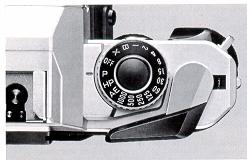 |
The function of the shutter is to
control the length of time the film is exposed to light. On the FX-103
Program, whether set in the Program AK. Aperture priority AE, or Manual
exposure mode, the shutter speed is controlled by an electronic circuit
incorporating a high precision quartz oscillator.
|
<Shutter Control Dial Settings>
"OFF" For switching off power, causing all
camera functions to cease. Set the dial to "OFF" when not using the camera.
"P" (Normal Program Mode) For taking pictures in the general program
AE mode.
"HP" (High-speed Program Mode) For taking pictures in the program AE
mode that favors a shutter speed slightly faster than that selected in the
Normal Program Mode.
"AE" For taking pictures in the Aperture-priority AE mode.
"1000" ~ "1" For exposure settings using the Manual
exposure mode. "1000," "500," "60," and "1" represent usable shutter speed
settings of 1/1000, 1/500, 1/60 and 1 second respectively. When the setting is
shifted to a next larger number For example, from 125 to 250), the exposure time
is successively halved with each setting; conversely, when shifted to a next
smaller number, the exposure time is successively doubled with each setting.
"B" The shutter remains open during the time the shutter release
button is kept pressed so it is used for taking long exposure shots.
"X" For shooting flash when the camera is used with a non-dedicated
flash unit. Operates camera at 1/100 sec. synch speed.
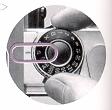 |
<Setting the Shutter Control
Dial> A. Set the shutter control dial by turning it until the desired click-stopped number aligns with the shutter speed index. |
Holding the Camera
In order to take a beautiful, in-focus photograph, it is necessary to
hold the camera steadily. Since most blurred pictures are caused by camera shake
(moving the camera at the instant of exposure), you should practice with the
camera until you feel accustomed to holding it properly. Hold the camera in the
palm of your left hand, using your fingers to rotate the focusing ring. Hold the
camera's handgrip firmly in your right hand, resting your forefinger on the
shutter release. With your left elbow against your body, hold the camera up to
your face firmly, and while looking through the viewfinder, press the shutter
release lightly. Besides the horizontal position, the camera can of course also
be used , to take pictures in the vertical position In any event, practice until
you find the positions that best suit your own photographic style.
Depending on conditions, it may also be a good idea to stabilize the camera by leaning your body against a building, resting the camera on a fence or other support, etc.
When all frames on a roll of film have been exposed, you will be unable
to operate the film advance /ever. Do not attempt to advance the film further,
as torn film may result. Check the exposure counter, and when it shows you have
completed a roll of film, always be sure to rewind the film into its cartridge
before opening the camera back. After removing the film, have it processed as
early as possible.
|
|
|
| [1] Press the film rewind release button on the base of the camera. Continuous pressing is unnecessary as the button is an automatically resetting type. | [2] Unfold the film rewind crank and turn it in the direction of the arrow. Keep turning until you feel a light resistance shortly before the film comes off the take-up spool and continue turning until the crank eventually rotates freely. |
Metering System
The FX-103 Program features a TTL full-aperture metering system that measures
the light coming through the lens at its maximum aperture. It is of the
"center-weighted" metering type which emphasizes the central portion of the
viewfinder image while taking into account the surrounding area seen in the
viewfinder.
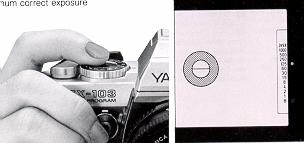 |
<Built in Exposure Meter> When the shutter release is pressed lightly, the switch for the built-in exposure meter is turned ON, and shutter speed LEDs inside the viewfinder will indicate the exposure in effect. Even after the finger has been removed from the shutter release, the exposure meter remains ON for 16 seconds before automatically turning itself OFF. Since the metering system is center-weighted, you can obtain optimum correct exposure by framing and metering your subject in the center of the viewfinder. |
<Light Reading Range>

The table gives the EV Light reading range for various lenses, showing
the inter-relationship between aperture, shutter speed and EV (exposure values).
For instance, when an f/1.4 lens at ISO 100 is used, the reading range spanning
the points that the vertical lines (EV) and the horizontal lines (shutter speed)
intersect with the diagonal lines extending from the f values of "1.4" to "16"
(representing the minimum aperture of the Yashica ML Lens f/1.4 50 mm), denotes
the reading range from EV 3 to 18.
* EV numbers, which are used to indicate the coupling range of the light meter,
denote the aperture and shutter speed combinations that yield the same exposure
effect on the film for a given lighting condition.
For example, when using EV 13 from the scale as a guide, it can be seen that the
same exposure effect is attained using the combinations of f/16 at 1/30 sec and
f/8 at 1/125 sec.
* The EV numbers from 3 through 18 and the shutter speed from 16 to 1/1000 sec.
represent the range over which the camera normally meters in the modes (P.
HP and AE Modes).
* That part of the metering range which is shown in color denotes the light reading range when using an f/1.4 lens at ISO 100.
Exposure Mode Selection
With the FX-103 Program, the shutter
control dial enables selection of any one of two program modes, aperture
priority AE mode, and manual exposure mode to suit any photographic objective or
requirement.
<Program AE Mode>
In the Program AE mode, the camera
automatically selects the optimum combination of shutter speed and aperture
settings for correct exposure according to lighting condition by using its
pre-programmed matching shutter speed and lens aperture settings. This
eliminates exposure worries, thus leaving you free to concentrate on composition
and making it a boon when it is top priority on capturing those fleeting,
decisive moments. For the desired objective, Program modes are available in
Normal Program and High-speed Program.
(1) "P" (Normal Program AE Mode) ... In this mode, the camera selects the
correct balance of shutter speed and aperture settings, making it easy even for
the beginning photographer to use the camera with confidence.
(2) "HP" (High-speed Program AE Mode) ... With this program mode, the camera
sets apertures in combination with shutter speeds that are slightly faster than
those selected in the Normal Program mode. It minimizes camera shake when using
telephoto lenses.
<Aperture-Priority AE Mode>
You set the lens aperture, and the
camera automatically selects the shutter speed according to the lighting
condition to give you the correct exposure combination. You will find it not
only suitable for general photography work but also for shots with depth of
field considerations because you can freely control the aperture setting.
<Manual Exposure Mode>
With this mode, you control the aperture
and shutter speed settings in selecting the correct exposure combination needed
to obtain the intended results or effect. And aided by the exposure information
displayed in the viewfinder, you can easily take those intentional over or
underexposed shots.
Using the Program AE Mode

(1) Set the Shutter Control Dial
to "P" This enables shooting in the Normal Program AE mode. To use
the High-speed Program AE mode, set the dial on "HP". The "P" mark will be
displayed in the viewfinder, indicating the camera is in the Program AE
mode. (Provided the metering system is switched on.)
(2) Set Aperture at Minimum Aperture Setting
Turn the aperture ring to its minimum setting. <Aperture Warning>
When the aperture setting is moved away from the minimum setting toward the
maximum setting, the "P" mark will pulsate at some settings. In this case, reset
aperture to the minimum setting.
(3) Focus and Compose Focus on subject using the
focusing ring, and compose your picture at the same time.
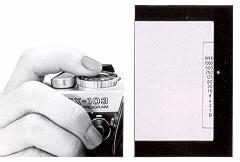 |
[4] Confirm Exposure and Shoot Touch the shutter release lightly and a lighted viewfinder LED will indicate the correct shutter speed in effect. If the shutter speed LEDs light at any setting from "1000" through "B." it indicates correct exposure. A lighted LED at "B" indicates a long time exposure up to 16 sec. Press the shutter release all the way to effect exposure |
· When a shutter speed of 1/30 sec. or slower is indicated, there is a danger
of camera shake.
In this case, use auto flash or support the camera with a
tripod.
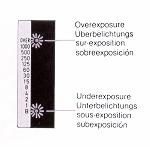 |
<Overexposure Warning> <Underexposure Warning> |
<Program AE Control Scale>
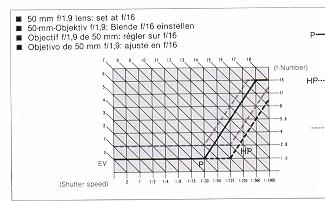 |
-- Normal Program -- High-Speed Program --- When using 28mm 2.8 lens8 |
The aperture and shutter speed combinations available in the Normal Program
and High-speed Program AE modes are as shown in the accompanying scale. The
scale shows the curves plotted for varying aperture and shutter speed
combinations when using a 50 mm f/1.9 lens. If a lens with a different maximum
aperture is used, such as a 28 mm f/2.8 lens for example, it will be as shown by
the dotted line.
· When using a lens with a maximum aperture under f/5.6, or with the Auto
Bellows, Microscope Adapter and such other accessories which do not couple with
the auto diaphragm mechanism, the program AE mode cannot be used. In this case,
use the Aperture priority AE mode or the manual mode to take your picture.
Using the Aperture Priority AE Mode
 |
[1] Set the Shutter Control Dial
at "AE"
The camera is now in the Aperture-priority AE mode. |
[2] Select the Aperture Setting Select the desired aperture by turning the lens aperture ring.
[3] Focus and Compose Compose the picture while focusing with a turn of the focusing ring.
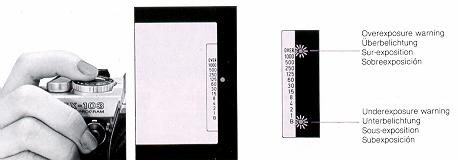 |
[4] Confirm Exposure Setting and Shoot Depress the shutter release lightly and the shutter speed LED will light, indicating the correct exposure in effect. If the LED lights steadily at any position from "1000" through "B", it indicates correct exposure. |
Then depress the shutter release the rest of way in to effect exposure. A lighted LED at "B" indicates a long time exposure up to 16 sec. When two LEDs light up simultaneously, an intermediate shutter speed somewhere between the two indicated speeds will be used.
· If a shutter speed of 1/30 second or slower is indicated, there is a danger
of camera shake with hand held shots. In this case, use auto flash, or support
the camera with a tripod.
<When LED at "OVER" Pulsates> This indicates an overexposure
setting because of excessive lighting on subject. Stop down the aperture until a
usable shutter speed is indicated. If the "OVER" LED still pulsates after
adjusting aperture, then use an optional neutral density filter.
<When LED at "B" Pulsates> This indicates an underexposure setting. Since your subject is too dimly lit, select a wider aperture. If the "B" LED still pulsates after adjusting aperture fully, then use auto flash or supplementary illumination.
|
|
|
Set the Shutter Speed. Turn the shutter
control dial to the desired manual shutter speed setting.
Set the Lens Aperture. Turn the lens aperture ring to the
desired aperture setting.
[3] Check the Exposure and Shoot
Depress the shutter release lightly and the shutter speed LED will
pulsate to indicate the user-selected shutter speed, and will light up to
indicate the correct shutter speed for the aperture setting in effect (Figure
1). For correct exposure, adjust the shutter or aperture settings until the
pulsating and steadily lit LEDs merge (Figure 2).
Now, depress the shutter release all the way to effect exposure.
· When two steadily lit LEDs appear at the same time, it will not be possible to
merge the LEDs by turning the shutter control dial. In this case, merge the LEDs
by a fine adjustment of the aperture ring.
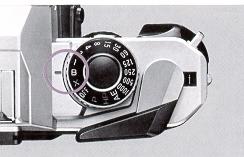 |
<"B" (Bulb) Photography> When making photographs of stars, or other photography at night requiring long exposure times (1 second or longer), set the shutter control dial to "B" (Bulb). In this mode, the shutter will remain open, and the film will be exposed for as long as the shutter release is held depressed. |
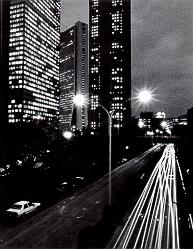 |
In this case, camera shake is inevitable with hand-held photography, thus the camera should always be mounted on a tripod, or rested on a solid surface to keep it immobile. To further remove any possibility of camera shake, the Cable Switch (optional accessory) should be connected to the camera. |
Exposure Compensation
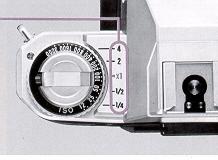 |
In automatic exposure photography (P. HP and AE modes), there may be situations where correct exposure is unattainable because of strong backlighting or harsh contrast in lighting conditions between subject and background. In such cases, as well as when you wish to take intentional over or underexposed shots, you will need to use the exposure compensation function. |
|
|
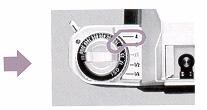 |
Exposure compensation is accomplished using the film speed dial. Normally,
the film speed value of the film in use is set opposite the "X1" position on the
exposure compensation index. For exposure compensation, depress the
film-speed-dial release, and turn the dial until the speed value of the film in
use lines up with the desired compensation index reading. The exposure
compensation index can be used at intermediate settings and can be click-stopped
in 1/3 increments between index readings.
Always reset the ISO speed value for the film being used to "X1' when
exposure compensation is no longer needed.
· The usable compensation range varies with the speed rating of the film in
use, so the following table has been provided as a guide.
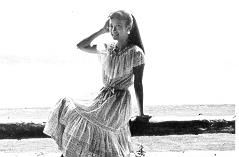 |
 |
Values "2" and "4" Increase the
Amount of Exposure In situations such as shooting against the light or where your subject is back-lit by a bright sky or beach scene, or when you want to overexpose intentionally, set the dial at "2" or "4". The "2" setting corresponds to a change of one f-stop, and the "4" to two f-stops. |
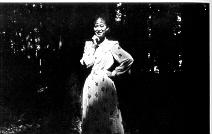 |
 |
Values "1/2" and "1/4" Decrease
the Amount of Exposure In situations where the background is dark because of spotlighting of the subject or where you want to underexpose intentionally, set the dial to "1/2" or "1/4". The "1/2 " setting corresponds to a change of one f-stop, and the "1/4" to two f-stops. |
When you wish to include yourself in a group or special occasion
picture, use the camera's quartz self-timer. Once you press the self-timer button
it double functions as a self-timer flasher (LED) to indicate
that the self-timer is in operation.
 |
[1] First focus the camera and advance the film. Then slide the self-timer/battery check lever in the direction of the arrow until the white index mark aligns with the white mark above the self-timer. |
[2] Once the self-timer button/flasher is pressed, it will begin
flashing for about 10 seconds before the shutter is automatically tripped. The
flashing rate will accelerate about two seconds before end of countdown to let
you know that the shutter is about to be released. You can cancel the self-timer
at any time during countdown by repressing the button. After using the
self-timer, reset the self-timer/battery check lever to its original position.
· The shutter can be activated by pressing the shutter release even in the midst
of a self-timer countdown. When this is done, the self-timer will cancel and the
self-timer flasher will be turned off.
· Resetting of the self-timer/battery check lever to its original position will
not cause the self-timer to cancel during its countdown.
· During the self-timer countdown period, the LED display inside the viewfinder
will be turned off.
· The self-timer will not function when the shutter control dial is set at "B".
 |
When shooting in the Program Auto (P. HP) or Aperture Priority Auto (AK) Modes using a self-timer or remote control system, the meter reading may be thrown off by stray light entering via the viewfinder eyepiece as it is not being shielded by the nearness of your face. |
In this case, attach an accessory eyecup to the viewfinder eyepiece as shown
in the illustration, slide it up and fold the rubber part against the viewfinder
eyepiece to shield out stray light. Alternatively, you can use the stray light
prevention adapter supplied with the camera to shield the viewfinder eyepiece.
For the use of the stray light prevention adapter, see the enclosed instruction
sheet.
Release Socket/Interchangeable Camera Back
 |
<Release Socket> This may be used to attach remote control devices such as the Cable Switch, Infrared Controller S. Radio Controller, etc., or as a contact for connecting the Auto Bellows or the RTF 540 flash unit. The socket receives electrical signals from these accessories which are used to operate the shutter. |
· Do not connect an ordinary cable release (mechanically operated type) to this
release socket as this can cause damage to the socket device.
<Interchangeable Camera Rack>
The standard camera back can
be interchanged with the cordless Yashica FX Data Back Quartz for imprinting the
date and/or time on the photographs. To remove the camera back, loosen it while
pushing down on the camera back release lug.
Infrared Compensation Mark
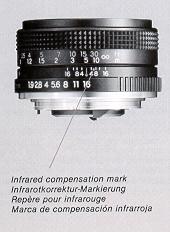 |
Since shooting with monochrome infrared film (and red filter) will result in
focusing on a different film plane than when using the normal focusing
procedure, focusing must be compensated for this variance. Both Yashica ML and
Zeiss T. lenses have an infrared compensation mark on the depth-of-field scale.
First use the normal focusing procedure with the red filter off, then mount the
filter and turn the focusing ring unit until the distance focused upon is
opposite the compensation mark.
· Please refer to film guide sheet when using color infrared film. |
Depth-of-field
One property of lenses is that when they are focused on a certain object, not
only the subject itself, but all objects in a certain range in front and back of
the subject will appear acceptably sharp in the picture. This range is called
the depth-of-field. The depth-of-field of a given lens varies, as follows.
 |
(1) If the aperture is stopped down, the depth-of-field increases; if the aperture is opened up the depth-of-field decreases. |
(2) As the distance to the subject increases the depth-of-field increases; as the distance to the subject decreases the depth-of-field decreases.
(3) The depth-of-field is greater behind the subject on which the lens is
focused than in front of it. Different lenses may have different depth-of-field
limits. A lens of short focal length has greater depth-of-field at any set
distance than a lens of long focal length.
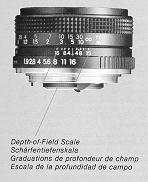 |
<Depth of-field Scale> The actual depth-of-field of a lens is shown by a scale shown on the lens. For example, when a 50 mm lens is focused at 5 m and the aperture setting is f/16, objects at distances between the two "16" figures on the depth-of-field scale, in this case from about 2.7 m and infinity will appear acceptably sharp to the unaided eye. |
Flash Photography
When shooting indoors or at night, the use of an electronic flash unit
is recommended.
The FX-103 Program, when teamed with the Yashica CS-203 Auto
flash unit, can be used for TTL metered flash exposures.
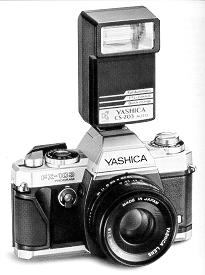
|
<Flash Photography with the CS-203 Auto flash Unit> TTL metered flash exposures with the CS-203 Auto flash unit can be made with the camera merely set in, one of the AE modes (P. HP or AE mode). The TTL flash metering system reads the through-the-lens-light reflected off the film surface and cuts off flash output when proper exposure has been made. This allows the use of all apertures, and the easy execution of advanced flash techniques such as bounce and diffused flash. |
· When used with the Contax TLA electronic flash system, the FX-103 Program
can likewise be used for TTL flash exposures.
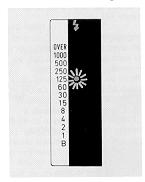 |
<Flash Synch Speed> When the dial is set at settings "60" through "1," and at "X" or "B." the synch speed will be at the respective shutter settings. |
<Dedicated Flash Signal Mark>
When dedicated flash unit is used, a flash ready LED mark "
![]() in the viewfinder will light upon recycling of the flash unit. When
undertaking TTL flash photography, the same LED mark will pulsate for two
seconds after exposure to indicate correct exposure; otherwise, the LED will
remain unlit after exposure.
in the viewfinder will light upon recycling of the flash unit. When
undertaking TTL flash photography, the same LED mark will pulsate for two
seconds after exposure to indicate correct exposure; otherwise, the LED will
remain unlit after exposure.
When the FX-103 Program is used with the Yashica flash system, the
operating patterns of the LED display upon recycling of the flash unit are as
shown in accompanying
| Flash Unit | Dedicated Flash Mark Lights | Automatic Setting of Synch Speed (LED Flashes) |
| CS-203 Auto | * | * |
| CS-202 Auto * | * | * |
| CD-201 Auto * | * | * |
| CS-14 | -- | -- |
| CS-10 | -- | -- |
* Does not have TTL flash capability.
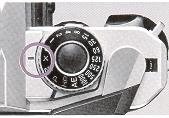 |
<Using Other Flash Units>
The synch contact of the FX-103 Program is an X contact (1/100 sec). Set the shutter control dial to "X" (shutter speed LED will flash at the "125" position) or at a shutter speed of 1/60 sec. or slower. |
· When using other electronic flash or flash bulb unit, use one of the cordless type.
· With flash bulb units, use a shutter speed of 1/30 see, or slower.
|
|
|
|
| <CS-203 Auto> This is a
compact TTL automatic electronic flash (guide number 20) designed for use
with the FX-103 Program. Since the light from the flash is controlled within
the camera, you can enjoy flash photography with very simple operation.
|
<FX Data back Quartz> This data back utilizes a cordless link to the camera body. It features a highly accurate digital quartz clock allowing your choice of five recording modes: (1) Year/month/day; (2) Day/Hour/Minute; (3) Counter (4) Any 6 digit number desired; (5) No data. Data is recorded in seven segment numerals. | <139 Winder II>--Contax Product--
This is a compact film auto-winder equipped with a release button for
vertical format photography. Winding speed is two frames per second.
Photography can be performed in the auto (P. HP and AK) mode, or manual,
using any shutter speeds desired.
|
Specifications
Type: 35 mm focal-plane type A jingle lens reflex camera.
Image Size: 24 x 36 mm
Lens Mount: Contax/Yashica bayonet mount.
Shutter: Electronically controlled, vertical travel, metal focal plane shutter (quartz-oscillator timed).
Shutter Speeds: Auto: 16 sec. to 1/1000 sec.; Manual: 1
sec. to 1/1000 sec. (11 steps); X synch; and B (Bulb).
Flash Synchronization: In direct X-synch only, automatically
synchs at 1/100 sec. With dedicated flash unit, automatically synchs at 1/100
sec. even with shutter speed settings at 1/1000 to 1/125 sec. in the P. PH or AE
modes. (Flash synchs at 1/30 sec. or slower with flash bulb units.)
Self-Timer: Quartz-timed electronic self-timer with 10 sec. delay. LED flashes during operation, accelerating 2 see, before activating shutter. Cancelable during countdown.
Shutter Release: Electromagnetic release system, with dedicated release socket.
Exposure Control: (1) Normal Program AE mode; (2) High-speed Program AE
mode; (3) Aperture-priority AE mode; (4) Manual exposure mode; (5) TTL Auto
Flash mode; and (6) Manual Flash mode.
Metering System: TTL center-weighted metering at full aperture
(direct center-weighted metering when using CS-203 electronic flash and TLA
electronic flash system), via Silicon Photo Diode (SPD) cell. Metering range
from EV 3 to 18 (f/1.4 lens, lSO 100). Film speed range from ISO 12 to 3200.
Metering switch activated by lightly touching shutter release button
(automatically cutting off after 16 sec.).
Exposure Compensation: + 2 EV to -2 EV (control doubles as film speed dial).
Viewfinder: Eye-level, pentaprism type. Shows 95% of picture area. 0.86 magnification (using 50 mm lens set at infinity).
Focusing Screen: Horizontal split-image/microprism collar on matte screen.
Viewfinder Display: LED display: Shutter Speed LEDs (indicating correct exposure, oven and underexposure), program AE mode indicator, dedicated flash mark. Shutter speed scale panel.
Film Advance: Lever operated. 130-degree winding angle
(20-degree stand-off angle); with provision for using with the Contax 139 Winder
II.
Film Rewind: Type using rewind release button and film rewind
crank.
Exposure Counter: Auto resetting, additive type.
Camera Back: Opens by lifting film rewind knob; detachable type; provided with memo holder.
Power Source: Uses two 1.55 V silver oxide (SR44) batteries, or two 1.5 V alkaline (LA44) batteries.
Battery Check: Self-timer/battery check LED used to check battery condition.
Dimensions: 138 (W) x 90 (H) x 54 (D) mm.
Weight: 460 grams (without batteries).
* The above specifications and design are subject to change without notice.
Camera Care
· Avoid leaving the camera too long in the heat (at the beach or in a car
under direct sunlight during summer months) as this can impair film and battery
performance and have an adverse effect on the camera itself.
· Salt air, sand, dirt and other foreign matter will damage the camera's
internal system if allowed to penetrate inside. Take care to keep the camera
clean when using it at the seashore or in sandy areas. Shocks from dropping or
bumping are another major cause of camera malfunction. Always handle your camera
with great care to ensure years of trouble-free operation.
· Avoid touching the lens, viewfinder eyepiece and other glass surfaces with
your fingers. Blow dust and dirt away from these surfaces with a blower/brush,
or wipe gently with a soft cloth (after brushing) if necessary. Clean smudges
and smears on lens and mirror surfaces with high quality lens-cleaning solution
and tissue. Always take extra care in cleaning the lens and mirror surfaces to
avoid scratching.
· When the camera is suddenly brought out of the cold into a warm room, the lens
and viewfinder surfaces may become fogged. The fogging will clear away in time
but any condensation on the internal mechanism can cause corrosion. Thus, guard
against exposing the camera to drastic temperature changes.
· When taking pictures of those important occasions such as an overseas trip or
wedding, be sure to make an advance check of the camera's operating condition.
Bringing along a spare set of batteries is recommended.
· When the camera body needs cleaning wipe it with a soft, dry cloth. Never use
any benzene, thinner or any other solvent on the camera body surface.
· When not using the camera for a long period, remove the batteries and avoid
leaving the camera in humid or naphthalene-treated areas.
<Camera Maintenance>
· Avoid leaving the camera in a humid or dusty area, in a mothproof treated
chest, or in laboratory where chemicals are stored. Keep the camera in a well
ventilated area.
· When not using the camera for an extended period, remove the batteries so as
to prevent damage from battery leakage.
In order to get the best performance from this camera, we recommend the use of
Yashica and Contax brand lenses and accessories. We take no responsibility for
damage to the camera from the use of other brands of products said to be for use
on Yashica or Contax cameras.